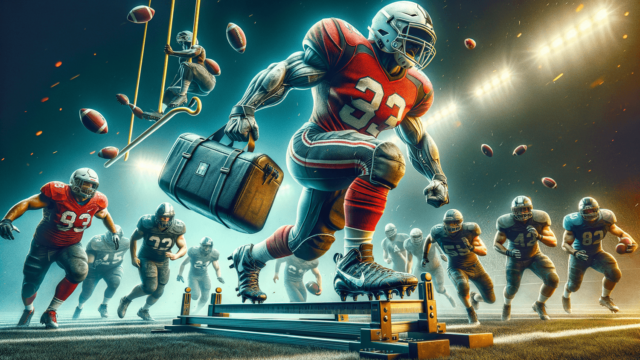
A standard football weighs approximately 410-450 grams (14-16 ounces) and has a circumference of 68-70 cm (27-28 inches).
Understanding Football Weight
A standard football weighs approximately 410-450 grams (14-16 ounces) and has a circumference of 68-70 cm (27-28 inches). The weight of a football is an essential aspect, as it determines the game’s consistency and performance.
Regulation Football Sizes and Weights
Size 5: Official Adult Size
The official FIFA-regulated adult football size is 5. This ball has a circumference of 68-70 cm (27-28 inches) and weighs between 410-450 grams (14-16 ounces). This size is used in professional leagues and international matches worldwide.
Size 4: Youth Football
Youth footballs, most suitable for players aged 8-12, are size 4. These balls have a circumference of 63.5-66 cm (25-26 inches) and weigh between 350-390 grams (12-14 ounces).
Size 3: Junior Football
For children aged 6-9, junior footballs are size 3. These balls have a circumference of 58.5-61 cm (23-24 inches) and weigh between 300-320 grams (11-12 ounces).
Size 2 & 1: Mini Footballs
Size 2 and 1 footballs are designed for small children, skill practice, and recreational purposes. Size 2 footballs have a circumference of 53-55 cm (21-22 inches) while size 1 footballs measure 46-48 cm (18-19 inches) in circumference. Both sizes weigh less than 280 grams (10 ounces).
Materials Impacting Football Weight
The materials used in manufacturing a football play a significant role in both its weight and performance. Traditional footballs are made of leather, while modern balls use synthetic materials like polyurethane and rubber. Natural leather tends to be heavier and less waterproof compared to synthetic materials.
Air Pressure and Football Weight
While discussing the weight of a football, it is also important to consider air pressure. The correct inflation pressure for a standard size 5 football is between 0.6 to 1.1 atmospheres (8.7 to 15.6 psi). Proper inflation ensures optimal performance, bounce, and weight distribution. Too much or too little air pressure can cause the ball to become unbalanced and negatively impact play.
Weather Conditions and Ball Weight
Weather conditions, like rain and humidity, can have a noticeable impact on a football’s weight. A wet ball may absorb water, increasing its weight and making it more difficult to handle, pass, or shoot. Manufacturers work to improve water-resistant properties in modern footballs using advanced surface treatments, coatings, and materials.
FIFA Quality Program
To ensure the highest quality in football production, FIFA introduced the FIFA Quality Program. This program sets international standards for football manufacturing, ensuring that approved footballs meet stringent requirements for weight, size, material, shape, and performance under different playing conditions.
Maintenance and Care
To maintain the optimal weight and performance of a football, proper care and storage are essential. After using the ball, it is recommended to wipe off any dirt or moisture with a clean, dry cloth. Storing footballs in a cool, dry place will help preserve their shape and structure. Regular air pressure checks and inflation adjustments can also help maintain the correct weight and performance characteristics.
FAQs on Football Weight and Related Topics
Here are some frequently asked questions and their concise answers to provide you with additional information on football weight and related topics.
Why is the weight of a football important?
The weight of a football is important because it affects the game’s consistency and performance. A well-balanced and properly weighted football ensures accurate passes, shots, and improved handling, allowing players to showcase their skills.
What size ball should I choose for adult recreational football games?
Adult recreational football games should use a size 5 football, as it’s the standard official adult size with a circumference of 68-70 cm (27-28 inches) and weighs between 410-450 grams (14-16 ounces).
How can I ensure that my football is properly inflated?
To ensure your football is properly inflated, use a reliable air pressure gauge to measure the pressure. Inflate the ball to its recommended pressure range, typically between 0.6 to 1.1 atmospheres (8.7 to 15.6 psi) for a standard size 5 football.
Do different brands of footballs weigh differently?
Different brands of footballs may have slight variations in weight, but they usually fall within the standardized range for each size category. FIFA-approved footballs must meet set standards, ensuring consistency in weight and performance among different brands.
What type of football performs better in wet conditions?
Synthetic footballs, such as those made from polyurethane, usually perform better in wet conditions due to their water-resistant properties. These materials minimize the amount of water absorbed by the ball, resulting in consistent weight and performance during play.
Featured Posts
- No pillar pages found.





